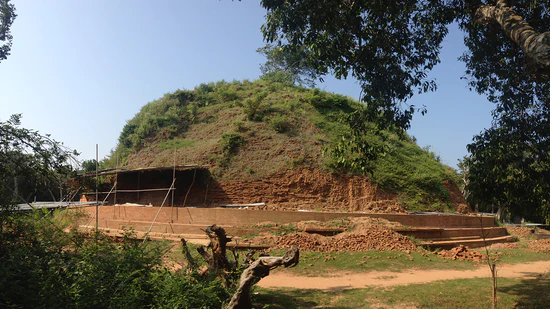
- Leave a review
- Share
- prev
- next
Story
By Ama H. Vanniarachchy
The large ruined brick stupa lies under the scorching sun. The long dry grasses are dancing in the wind under the bright blue sky. The place seems to be forlorn and forsaken in time, for decades.
Yet, this is no ordinary place. This is a place where a hero was born. This is a place where the greatest savior of our nation, of the Sinhalese, according to legend and lore, was conceived in a human womb. This is a place that decided the fate of our nation, during a very fateful time. The sacred Lahugala Kota Vehera monastery is the place where prince Dutugamunu is said to be conceived in the womb of the valorous queen, Viharamaha Devi.
Located on the Monaragala – Pottuvil main road, Lahugala Kota Vehera is also known as the Kota Pabbatha, Kotagala Vehera, or Lahugala Stupa. The largest known image house in ancient Ruhuna could be seen at this religious site. This is one of the few Kota-Vehera-style stupas discovered in Sri Lanka.
What is interesting about this stupa is that it was built to commemorate the conceiving (not the birthplace) of the heroic Sinhalese king Dutugemunu. According to folklore, this was built at the place where a novice monk (samanera) who is believed to be reborn as Dutugamunu lived.
Today, we shall embark you on a journey, back in time, to witness the story of incredible valor, courage, and patriotism.
This is a tale of war and peace, love, romance, brotherhood, friendship, and determination. This is a story of a heroic woman’s courage and determination, as we have never witnessed before.
This is a fascinating story of one man’s unconditional and undying love for his people, land, and religion.
This is the story of Dutugamunu; the greatest patriotic king of the Sinhalese.
Join us and fill your heart with valor and excitement.
3rd century BCE, Magama kingdom, Ruhuna…
It was a doomed period in the history of Sri Lanka. The Sinhala king Asela was overthrown by a usurper named Elara who was of a noble origin as the chronicles say.
Elara, whose origin and ethnicity are still unknown, invaded the Anuradhapura kingdom and usurped the throne.
For four decades, he ruled. Although the chroniclers say he was a righteous king, he was not the rightful owner of the Sinhala throne. Also, as chronicles and other folklore say, during his time, Buddhism was not patronaged. The Sinhala Buddhist identity of the land was severely threatened. As one story narrates, once Elara drove his chariot at Segiriya (Chethiyagiriya or Segiriya was also the name of Mihintale) and his chariot hit the Dome of a ruined stupa. This means, that his chariot drove just so close to the stupa which will never happen to a Buddhist ruler. No one would drive a vehicle so close to a stupa that it would hit and damage the stupa. This also means that the stupa was in a ruined state and the country too. The road to Segiriya was ruined and covered with vegetation. This story is a piece of strong evidence to understand the state of Elara’s rule in Sri Lanka.
Segiriya was an important temple and according to this narration, the road that led to the temple was in such a state the king’s chariot road hit and damaged a stupa.
Further, as chronicles and folklore narrate, the Sinhala power was weak in the Northern plain of the island. The king of Ruhuna, where Magama was the capital, was the only savior of the nation.
By this time, king Kavanthissa was the king of Ruhuna. He was a visionary king, a king who saw the future and who had great plans to save the nation. He, along with his queen, Viharamaha Devi paved the path to save the nation and the Sinhala throne from a usurper. He made early plans to unite the country and prepare the country for a war against a powerful usurper. His plans, his dreams were made a success by his two heroic sons, Dutugamunu and Saddhathissa.
A hero is born at Lahugala Kotavehera…
As per the chronicles, a samanera (a novice monk) lived at Kotagala vihara. He was known to be a pious, virtuous samanera who followed the path of Buddha accurately. However, it is said that he was physically weak and sick. Once, he fell sick and was on his deathbed. Knowing that, queen Viharamaha Devi invites the novice to be born as her child. This story is elaborate narrated in the Mahavamsa as follows:
” ……… In the monastery named Kotapabbata there lived at that time a samanera, pious in his way of life, who was ever busied with various works of merit.
To mount the more easily to the courtyard of the Akasacetiya he fixed three slabs of stone as steps. He gave (the bhikkhus) to drink and did services to the brotherhood. Since his body was continually wearied a grievous sickness came upon him. The grateful bhikkhus, who brought him in a litter, tended him at the Tissarama, in the Silapassayaparivena.
Always when the self-controlled Vihäradevi had given lavish gifts to the brotherhood in the beautifully prepared royal palace, before the mid-day meal, she used to take, after the meal, sweet perfumes, flowers, medicines and clothing and go to the arama and offer these (to the bhikkhus) according to their dignity. Now doing thus, at that time, she took her seat near the chief thera of the community (in the vihara), and when expounding the true doctrine the thera spoke thus to her: `Thy great happiness thou hast attained by works of merit; even now must thou not grow weary of performing works of merit.’ But she, being thus exhorted, replied: `What is our happiness here, since we have no children? Lo, our happiness is therefore barren!’
The thera, who, being gifted with the six (supernormal) powers, foresaw that she would have children, said: `Seek out the sick samanera, O queen.’ She went thence and said to the samanera, who was near unto death: `Utter the wish to become my son; for that would be great happiness for us.’
And when she perceived that he would not, the keen-witted woman commanded, to this end, great and beautiful offerings of flowers, and renewed her pleading. When he was yet unwilling, she, knowing the right means, gave to the brotherhood for his sake all manner of medicines and garments and again pleaded with him. him.
Then he did desire (rebirth for himself in) the king’s family, and she caused the place to be richly adorned and taking her to leave she mounted the car and went her way. Hereupon the samanera passed away, and he returned to a new life in the womb of the queen while she was yet upon her journey; when she perceived this she halted. She sent that message to the king and returned with the king.
When they two both had fulfilled the funeral rites for the samanera they, dwelling with collected minds in that very parivena, appointed continually lavish gifts for the brotherhood of bhikkhus. …. “
It is generally believed that Lahugala Kotavehera is the ancient Kotagala vehera in which the novice monk who was later reborn as king Dutugamunu lived. Therefore, the Kota vehera or the stupa is believed to be built to commemorate the birth of this heroic warrior king.
The interesting fact is that the king's life is celebrated in a grand manner in local history, culture, literature, and folklore. A stupa has been built to commemorate the past life of the king. Lore is woven around the future birth of the king. It is said that he will be born as one of the two most faithful disciples of the future Buddha Maitreya. Dutugamunu is celebrated as a great warrior and hero and the greatest savior and patronage of Buddhism in local Pali literature. A stupa has been built to honour him after his death, at the place where he was cremated. The war between Dutugamunu and Elara has been glorified in the arts; especially during the late medieval period art. The famous wall painting at Dambulla raja maha vihara elaborates on the Dutugamunu Elara war. Two large stone carvings of Dutugamunu on his tusker Kandula and Elara on his tusker Parvatha can be seen at the entrance of the Kandy Dalada Maligawa.
Also, it is said that the great tusks of the king’s tusker Kandula are kept at the Kataragama devala premises. The Kataragama devale perahera is also held annually following the orders of Dutugamunu, for more than two millennia now.
This shows the importance of this king and how his life has been embedded in the consciousness of the Sinhala Buddhists as a savior of their nation and identity.
To be continued…
Reference
Mahavamsa or The Great Chronicle of Ceylon (English Translation) by Wilhelm Geigar, (1912)
Shortcode
Categories
- 32

